Say Hello ⁺ to TB Health
Universiti Malaya outlines its prototype intelligent mobile phone app for tuberculosis treatment and monitoring, potentially the most comprehensive and user friendly experience to date

Tuberculosis (TB) has the highest global incidence in Southeast Asia, which accounts for 44% of new cases worldwide, with Malaysia and Singapore showing increasing or static incidence rates and a rising burden of disease. With an estimated prevalence rate of 25% for latent tuberculosis infection (LTBI) in Malaysia, this translates to 8 million potential LTBI carriers.
Statistics released by the World Health Organisation (2018) shows that 10% of LTBI patients develop active TB, which is 30 times costlier to treat, adding a potential RM40.3 (USD9.8) billion required for treatment.
The sobering reality is that an alarming 25% of our active TB patients default treatment. Poor treatment compliance may lead to undesired outcomes, primarily multidrug-resistant TB (MDR-TB), with higher mortality rates and far higher treatment costs. Without a concerted effort by Southeast Asia to eradicate TB, the potential nightmare of ~MYR51,000,000 (USD 12.4 million) annually to treat MDR-TB (based on Malaysian MDR-TB prevalence and cost differences between MDR-TB and non-MDR-TB treatment) may become a reality.
With the movement of migrant workers between Southeast Asian countries, TB is a major public health issue, causing more mortality per year compared to COVID-19. Adherence to Directly Observed Therapy Shortcourse (DOTS), the traditional six months daily face-to-face intervention for TB, is hampered by logistical challenges, costs and distance to healthcare facilities, with 80% of treatment costs being borne by patients for transport and lost work hours.
In line with WHO’s suggestions within their “End TB Strategy” and a recent research conducted in University Malaya Medical Centre (UMMC) that observed DOTS non-adherence, UMMC has proposed to build a digital platform providing video-based DOTS (vDOTS) to improve the traditional DOTS. In fact, vDOTS has been found to be cheaper while boasting better treatment compliance rates than traditional DOTS, saving up to RM364,771 (USD88.9) per year.
This solution, branded as UMMC’s Hello+ (Hello Health) initiative, makes TB treatment more convenient and accessible, to overcome barriers to DOTS compliance, thereby reducing the economic and disease burden of TB on the Malaysian public healthcare system.
INNOVATION
Fig. 1 shows an overview of the proposed vDOTS wireframe comprising two modules, namely: self-reporting (patients) and monitoring (healthcare professional).

Fig 1. Proposed Video DOTS Wireframe
First, registered UMMC patients are required to login using their personal IDs and passwords, accomplishing user authentication (Fig. 2).
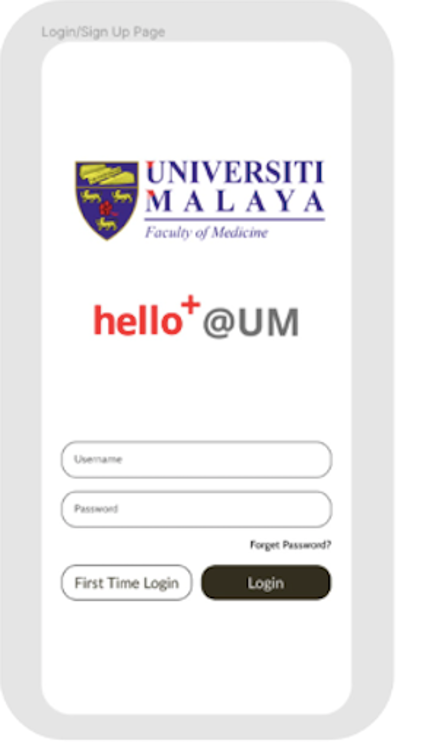
Fig. 2. Login screen
They are then required to upload live videos of them consuming TB medications as per the DOTS guidelines, and thus thwarting any attempts to upload older footages to fake adherence. Further, no options are provided to access video galleries and timestamps will be embedded as an additional security measure (Fig. 3).

Fig. 3. Live video upload
Additionally, the process of confirming medication ingestion will be automated through facial recognition technology, hence eliminating the need for manual inspections. Healthcare staff will be alerted about non-compliant patients that require follow-up, while sending out reminders to the patients as well. Further, the data collected helps to exhibit drug consumption habits of individual patients in a more user-friendly format (Fig. 4), and the use of live videos ensures data accuracy compared to the current practice of using logbooks (Fig. 5).

Fig. 4. Tracking Daily Progress/Compliance Pattern in an Easy-to-Read Format

Fig. 5. Sample of latest patient logbook in UMMC
Medical knowledge regarding TB and DOTS will be featured in the system to overcome health literacy whilst a comprehensive FAQ with easy to understand ‘how-to’ videos and tips will be provided to improve digital literacy even for the least tech savvy users (Fig. 6; Fig. 7). This information will be in multi-languages to cater for the multi-ethnicity population. Synchronous teleconsultations will be made available for face-to-face interactions (Fig. 8).
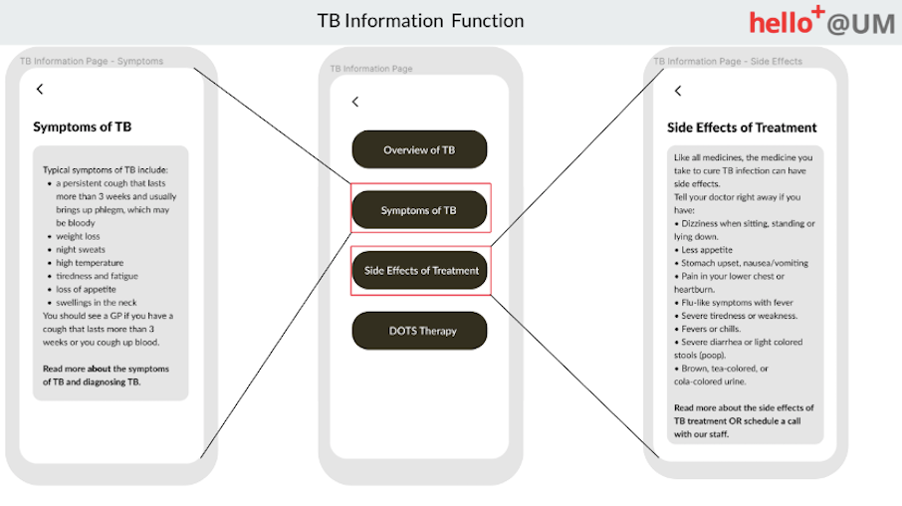
Fig. 6. TB Information – Sample
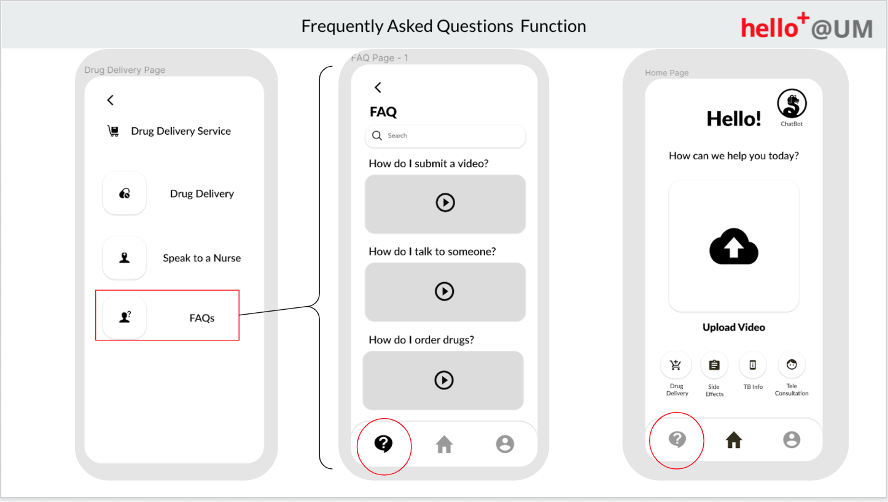
Fig. 7. FAQ screen
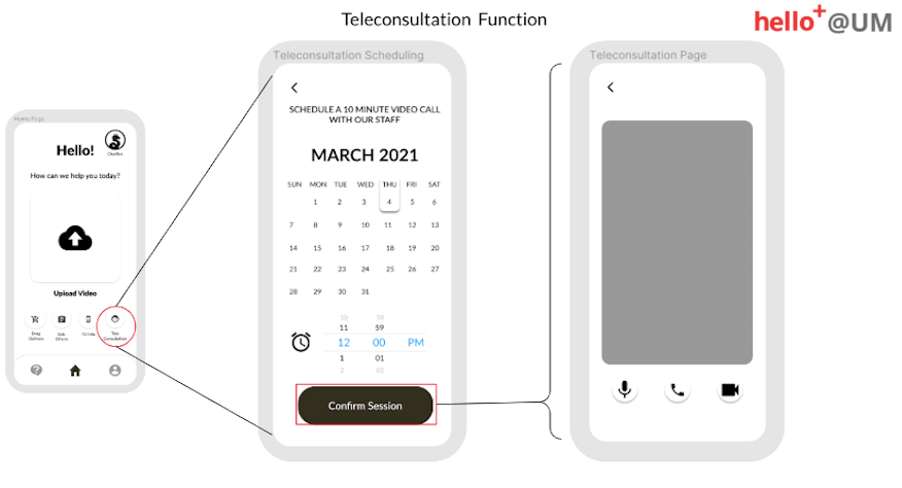
Fig. 8. Teleconsultation
Finally, our market feedback has shown a demand for drug-delivery and side-effect monitoring services (Fig. 9; Fig. 10), which we intend to incorporate via partnership with UMMC’s delivery service or Pos Malaysia. Compiling long term data on the side-effects will also allow the healthcare staff to create more precise treatment decisions, while utilising teleconsultation to provide urgent advice when necessary.
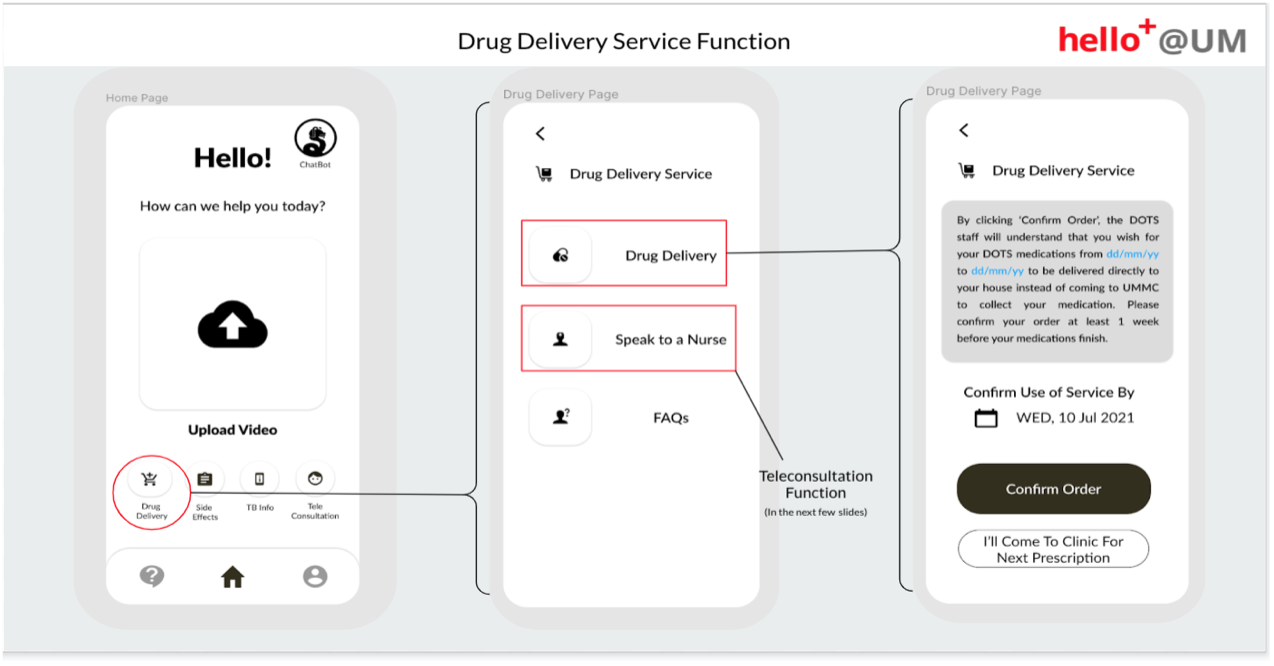
Fig. 9. Drug delivery service

Fig. 10. Side-effects monitoring
PRACTICALITY & VIABILITY
To build our prototype, we intend to use an already available Respiratory Unit webpage server. Utilising the principle of a lean start-up model, patient feedback will be continuously sought for continuous system improvement. Letters of intent to adopt vDOTS when successfully built have been obtained from the Respiratory, Primary Care, Palliative Units of UMMC and the Ministry of Health (MOH). With increasing patient support for Telehealth services due to COVID-19 and coupled with our market research findings showing 85% patients (20 of whom agreed to be beta testers) and 75% physicians being strongly supportive of the TB platform in UMMC, vDOTS is deemed to be in demand, timely and feasible. Furthermore, as UMMC uses its own internal EMR system, we are currently synchronising our platform with this system to help streamline daily clinical duties.
TB patients are not legally bound to complete their DOTS in Malaysia, therefore, to improve the non-adherence rate, we are establishing collaborations with the state government’s RM800 (USD195)/person incentivisation programme for TB compliance, utilising our platform for evidence of DOTS compliance as proof for claimants. Internet accessibility concerns for our platform are addressed as survey feedback shows 90% of our patients face no connectivity issues with making video calls. Finally, the existence of a secure and reliable Intranet system in the university ensures only authorised users can access the system, hence addressing data privacy and confidentiality concerns.
We acknowledge that vDOTS is not a new system, as it is utilised in the United States (AiCure, SureAdherence), for example. However, to the best of our knowledge a recorded vDOTS system is not in existence in Malaysia and it would be the first of its kind with a fully integrated electronic medical records in a multi-lingual, automated alert system for both patients and physicians, supporting both desktop and app with an easily scalable desktop version to ensure wider usage and utilising latest facial recognition technology. Further, our collaboration with public incentive programmes to tackle non-adherence issues through an easy-to-use and user-friendly system allowing long term monitoring of the patients can be utilised as national standards.
COMMERCIALISATION, MARKETING & BUSINESS PLAN
Our commercialisation strategy has three phases. Phase 1 targets all active and LTB patients in UMMC (~2,500), where we estimate to turn a net profit of RM31,000 (USD7,561) via a RM10 (USD2.4) per month subscription model (conservative 50% adoption rate). Considering the current TB market in UMMC is small, Phase 2 expands the platform, incorporating teleconsultations, side effects monitoring, drug delivery and forum Q&A for other UMMC clinics that tackle non-TB conditions, targeting ~1.2 million per year (and growing) number of patients that visit UMMC. With a monthly charge of MYR20 (USD4.88) and a conservative 20% adoption rate, an annual net profit x150 times greater than Phase 1 is estimated. This excludes additional revenue streams like digital advertisements, pay-per-use teleconsultation/drug delivery services (for non-subscribed patients) and sponsored articles by pharmaceutical companies/doctors. Finally, Phase 3 aims to turn our vDOTS into a national standard bearer serving our 32 million population. Proof of concept from Phase 1 including staff/patient testimonials and research showing the feasibility of vDOTS will serve as evidence when pitching to MOH Malaysian hospitals (and potentially beyond) to adopt the system via licensing agreements.
The main initial marketing strategy is to adopt a face-to-face approach to convince patients to migrate to vDOTS by pitching the platform as a “convenient and safe alternative” via pamphlets during consultations. It is also vital to point out hidden costs incurred by patients for DOTS (transportation, fuel, time consumed) during marketing to address patients who believe DOTS is free, and hence refuse to pay (based on survey feedback). A similar marketing strategy will be adopted in Phase 2 for non-TB clinics and patients, however, as Phase 2 covers a wider demographic, additional strategies will be utilised including partnering with social media content creators/influencers to create storylines targeting the digitally savvy patients and caregivers whereas traditional media targets older patients. Furthermore, our official Facebook account will be extensively promoted, along with “ask-us-anything” sessions for Hello+@UM.
LIMITATIONS
Potential hurdles anticipated include poor digital literacy rates among patients and staff, poor compliance despite vDOTS, lack of adoption due to privacy and security concerns, among others. Several measures are proposed, for example, staff training can be provided to improve digital literacy whereas live demo sessions can be held for patients. Further, in-house seminars can be provided to improve patient’s level of awareness with regards to privacy and security issues. We also intend to solicit continuous feedback from patients and staff to improve the system considering no benchmark is available for comparison.
CONCLUSION
Ultimately, it is hoped that TB treatment can be revolutionised with a new patient- and doctor-centric system with automations to improve patient-doctor interactions. This new adaptable and scalable patient-centric eHealth resource will better track and treat TB and other diseases such as COVID-19 that are both curable and preventable.
Author: Dr Ng Kee Seong
